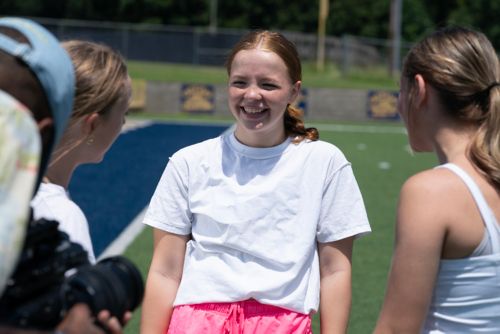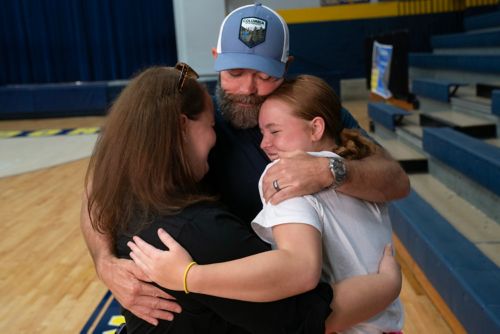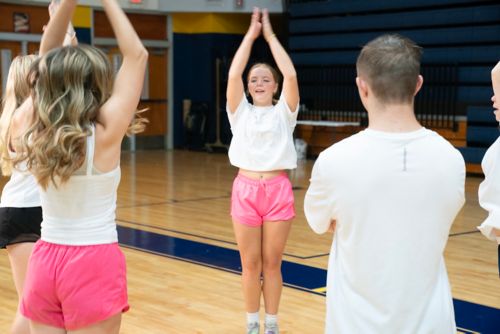Let’s Cheer: Transplant Cures Teen’s Aplastic Anemia

Annabelle Guy kept involved with cheerleading during treatment for aplastic anemia.
Annabelle Guy was short of breath, which was not normal for the competitive cheerleader. Her team ran several miles a day to keep in top physical form. During the summer of 2021, Annabelle felt herself falling behind her teammates.
At first, she thought it was the heat. After all, it was Mississippi during the summertime. But gradually she felt worse. She tired quickly and did not feel like eating. Her skin was pale.
So, her parents took her for a checkup. The doctor thought Annabelle might have exercise-induced asthma. But a complete blood count test showed that she had very low blood cell counts. Doctors knew that something was wrong, but the answer was not simple. Low blood counts can point to many different conditions.
It took a few weeks for the family to get a final diagnosis. At first, doctors thought Annabelle might have leukemia. But doctors ruled it out after running more tests.
Further testing showed Annabelle had a severe case of a rare blood disorder called aplastic anemia. Aplastic anemia happens when the bone marrow does not make enough blood cells. Bone marrow, the soft sponge-like tissue in the center of some bones, makes blood stem cells. These stem cells produce red blood cells, white blood cells, and platelets.
Aplastic anemia raises the risk of:
- Anemia (low red blood cells)
- Infections (low white blood cells)
- Bleeding too much (low platelets)
“It was a long process with lots of tests,” says her mom, Stephanie. “I think it took about 3 ½ weeks of not knowing exactly what she had. When we got her official diagnosis, we were just relieved to know we had a path to follow.”
Keeping track of information
Stephanie remembers being overwhelmed with information. She says it was like drinking water from a firehose. She took notes on her phone and sometimes used its voice recorder app to record care visits. She took photos of handouts. She put as much information as she could in a thick folder the hospital staff gave her.
The family was scared, but Stephanie says the situation brought them closer.
Sharing the news with others

Annabelle Guy takes a break during cheer practice to visit with her mom and dad.
At first, they did not tell anyone about Annabelle’s illness. They wanted to see how she handled the news and when she was ready for others to know.
Annabelle’s diagnosis was right before Thanksgiving 2021. The family was set to host the holiday meal, so they felt they had to share the news with family.
“Once we got a grip on it ourselves, we started slowly to share the news,” Stephanie says. “I wish we would have shared it a little more publicly to begin with because a lot of people don’t understand privacy and the rumor mills got churning.”
Going through treatment
The best treatment option for Annabelle was a stem cell (bone marrow) transplant. In this type of transplant, healthy blood stem cells from a matched donor are given to the patient. The goal is for the new, healthy bone marrow to begin making healthy blood cells.
A matched donor has stem cells with similar genetic markers. This is known as human leukocyte antigen (HLA) matching.
The search began for a matched donor. The donor can be a relative or unrelated to the patient.
Doctors prefer a sibling donor because siblings have the closest genetic makeup to the patient. But none of Annabelle’s siblings were a match. Next, the care team checked the National Marrow Donor Program registry. The registry is a list of people who have volunteered and have been screened to be donors. No one in the registry matched.
“That was very scary,” Stephanie says. “There are 9 million people registered, and out of 9 million people, no one matches your kid.”
The next step involved looking for a “half-match” known as a haploidentical match. The donor is usually a biological (birth) parent. Biological parents are a half-match because a child gets half their HLA from each parent. Sometimes siblings are a half-match.
A haploidentical transplant has more risks than one with a matched donor. The patient’s body is more likely to reject donor cells because it recognizes the new cells as foreign and may try to attack them. Patients have a higher risk of developing serious, sometimes life-threatening complications.
Because of the risks, Stephanie and her husband, Brian, chose another treatment option, a medicine called anti-thymocyte globulin (ATG). It can kill immune cells that attack stem cells in aplastic anemia patients. Patients must stay at the hospital for treatment. Annabelle went into the hospital the day after Christmas and stayed through New Year’s Eve.
But the treatment did not achieve the result they wanted. They tried other medicines. Nothing worked as they had hoped. After 6 months of trying other options, they decided to try the half-matched transplant.
Next, they needed to choose a donor. Annabelle’s younger brother was a half-match, but donors must be at least 18. Both parents had testing. Brian’s stem cells were a better match with Annabelle’s.
Annabelle received her dad’s donor cells. The transplant was a success.
“Ever since then, she’s been completely sustained on her own with her bone marrow,” Stephanie says.

Annabelle Guy thrives at competitive cheerleading.
Life after transplant
These days, Annabelle keeps busy with cheerleading competitions. She is a senior in high school. Annabelle managed to stay on track with school during her treatments.
Because her immune system was so weak, she missed 3 semesters of high school. The hospital’s school program and Annabelle’s high school worked with the family to help Annabelle keep up while she was out of school. Her parents paid for extra academic activities during the summer.
“We tried as much as we could to keep her involved in activities at school that weren’t indoors,” Stephanie says. “The hardest part of the diagnosis was the isolation.”
Annabelle is considered cured. She is applying to colleges and plans to become a medical examiner.
“Annabelle lives her normal, everyday life like it never happened,” Stephanie says. “But it did happen, and we know that. We are still dealing with the emotional scars. It never goes away. You never forget it. But you truly know how blessed you are, so it changes you forever.”





